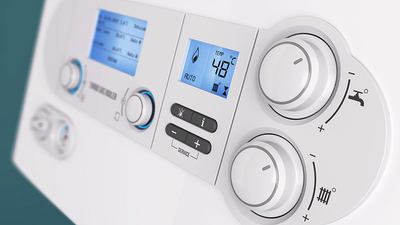The future of home heating: Moving beyond gas boilers

Starting at the source
Gas boilers are a common fixture in homes right across the country. In the UK, around 80% of homes are connected to the gas network, and boilers are the primary heat source supplying heating systems.
However, these familiar systems are gradually being phased out. New homes built after 2025 will no longer have gas boilers installed, utilising low-emission alternatives such as heat pumps instead. For existing homes, grants are available to support the transition to ground and air source heat pumps and, from 2035, it won’t be possible to install gas boilers in homes.
In the meantime, while the uptake of heat pumps continues to accelerate towards the target of 600,000 installations every year, government is working with industry to explore alternative ways of reducing emissions.
Introducing hydrogen to the gas network through a 20% blend could cut carbon emissions and make a significant contribution towards decarbonisation. Several trials have already been conducted to demonstrate the potential of a move towards hydrogen, forming a key part of the government’s Hydrogen Strategy, with findings suggesting a seamless transition to a hydrogen blend.
Each of these options in the future of home heating promise to support compliance with the Future Homes Standard which comes into effect from 2025, with the aim of reducing emissions of newly built homes by up to 80%, compared to homes built under today’s standards.

New trends in home heating
While it’s critical for installers to keep up to date with these changes to support their customers, there are other home heating trends emerging as homeowners undertake home improvements to enhance efficiency and reduce running costs.
The adoption of underfloor heating (UFH) is rapidly accelerating, making it one of the biggest growth areas of the home heating sector. Using a network of pipes beneath the floor, UFH moves homes away from traditional radiator central heating systems and towards a highly efficient solution that is hidden out of sight. Alongside the obvious aesthetic benefits of a system that’s integrated into the floor, UFH drives efficiency, too.
Operating at much lower temperatures than radiator systems (typically around 55°C rather than 65-70°C), UFH systems leverage a much greater surface area to evenly distribute warmth across a space. Its lower operating temperature means heat sources aren’t worked so hard, reducing energy consumption – and making them compatible with traditional and modern heat sources.
UFH is already being specified widely in new build properties, where systems can be easily integrated into building designs – often in conjunction with heat pumps. Uptake is also growing in existing homes, with retrofit UFH systems – such as JG LowFit – bringing the same operational benefits, with minimal disruption to install.
Smart control technologies such as advanced thermostats are also surging in popularity, enabling homeowners to stay in control of their heating. Paired with smartphone apps, users can effectively manage their heating to optimise comfort and control running costs.

The future of home heating
It’s clear that how we heat our homes is changing, and what has been the norm for decades will soon shift to the future of home heating, low-emission alternatives.
While heat pumps are already paving the way to change and hydrogen looks set to have a far-reaching impact when blended into the gas network, there are a host of accessible technologies available to homeowners today. UFH is already playing a leading role in cutting household emissions and elevating comfort for occupants.
For installers to play a leading role in advising their customers on effective home efficiency improvements and future-proofing their properties, it is important to have a complete understanding of the changes facing the industry – and the systems that will facilitate it.
When it comes to creating complete plumbing and heating systems, RWC’s JG Underfloor heating brand is well placed to support. As well as developing reliable solutions that underpin performance, JG Underfloor also makes its technical support available to professional installers, including the recent launch of a free e-Guide on underfloor heating.
Discover UFH
To discover the underfloor heating systems that are shaping home efficiency for the future, or to find out how JG Underfloor are supporting installers, click below.
